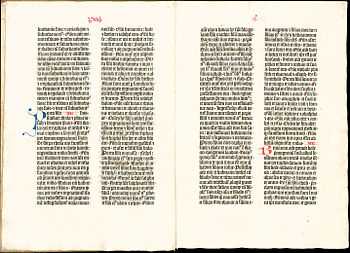36-line Bible
The 36-line Bible, also known as the "Bamberg Bible" [1] and sometimes called a "Gutenberg Bible", is the second printed edition of the Bible, after the Gutenberg Bible. It is believed to have been printed in Bamberg, Germany, about 1458-60. No printer's name appears in the book, but it is possible that Johannes Gutenberg was responsible.[1]

The name refers to the 36 lines of text printed on each page, and distinguishes it from the Gutenberg Bible, or 42-line Bible.
Date
In the past, some scholars argued that the 36-line Bible was an early and primitive version of Gutenberg's 42-line Bible, which would have meant it was printed prior to 1455.[2] Careful comparison of the texts, however, has since shown that, with the exception of the first few pages, the 36-line Bible was set from the Gutenberg Bible. This proves that the 42-line Bible came first.[3][4]
The date 1461 was marked by a rubricator in one copy of the Bible, showing that it could not have been printed any later than this.[5] Most scholars now agree that the 36-line Bible can be dated to 1458-60, making it the second printed edition of the Bible.[1]
A fragment exists of a 40-line Bible, probably printed around 1458 or earlier, and printed with the same type. However it is believed that the fragment is only a trial piece and that this Bible was never printed. It has been suggested that the first few pages of the 36-line Bible were set from the same manuscript used for the 40-line Bible fragment.[3]
Place of printing
Several pieces of evidence suggest that the 36-line Bible was printed in Bamberg, Germany. The paper used is known from Bamberg (and not from Mainz, the location of Gutenberg's press); copies exist in typical Bamberg style bindings; fragments were used to add padding to the bindings of other books printed in Bamberg; and almost all known copies have ownership records that can be traced back to Bamberg or its vicinity.[6]
Identity of printer
The printer's identity is unknown. It may have been Gutenberg, someone who had worked for him, or someone who had bought type and other equipment from him.[7] Several pieces of evidence show that Gutenberg was linked in some way with the 36-line Bible. In the 1980s cyclotron analysis performed by Richard Schwab and Thomas Cahill established that the ink used was similar to that used for the 42-line Bible.[2]
The type is a version of the so-called D-K type, also known as the 36-line Bible type.[8] This type is crude and older than that used for the 42-line Bible. It had been used for some very early works, probably predating the 42-line Bible and almost certainly printed by Gutenberg, such as an Ars minor by Donatus (various printings c. 1452-53) and several leaves of a pamphlet called the Turkish Calendar for 1455 (likely printed in late 1454), hence the name D-K for "Donatus-Kalendar".[8][9] Gutenberg lost much of his original equipment to his banker Johann Fust in a lawsuit in 1455, and it is possible this type was the only one left available to him.[10] A number of works seem to have been printed with the D-K type in Mainz between 1455 and 1459, perhaps by Gutenberg.[11]
Albrecht Pfister, who is known to have used the D-K type in Bamberg from at least 1461, has also been suggested as the printer.[5][12] Many authorities believe that Pfister is unlikely because later works known to be by him have poorer-quality printing.[13][14]
Surviving copies
Fourteen complete or nearly complete copies are known, all on paper, plus many fragments and single leaves from vellum copies, which have survived because they were used in the bindings of later books.[15] The small number of surviving copies suggests that far fewer were printed than of the 42-line Bible. A higher proportion may have been printed on vellum.
Eight of these copies are in Germany. This Bible has been much less sought after than the 42-line Bible, with a higher proportion remaining in Germany and only one having been acquired by an American library, an incomplete copy at Princeton University Library. A copy is on permanent display in the Sir John Ritblat Gallery in the British Library.
See also
References
Footnotes
- ↑ 1.0 1.1 1.2 British Library, "Early Printed Bibles - in Latin 1454 onwards"
- ↑ 2.0 2.1 Time Magazine, March 10, 1986
- ↑ 3.0 3.1 Stillwell p. 11.
- ↑ Kapr, Albert (1996). Johann Gutenberg: The Man and His Invention. Scolar Press. ISBN 1-85928-114-1.
- ↑ 5.0 5.1 British Library, Incunabula Short Title Catalogue Page accessed 6 July 2009
- ↑ Stillwell p. 14.
- ↑ Febvre, Lucien and Martin, Henri-Jean (1976). The Coming of the Book: the Impact of Printing. NLB. p. 181. ISBN 1-4999-9081-2.
- ↑ 8.0 8.1 Stillwell pp. 3–13
- ↑ Bridewell Library, "Gutenberg's earliest type"
- ↑ Orb Online Encyclopedia
- ↑ Stillwell pp. 10, 13-17, 19-21, 23-24.
- ↑ Stillwell pp. 38, 39, 52-54.
- ↑ Stillwell p. 14
- ↑ Fussel, Stephan (2005). Gutenberg and the Impact of Printing. Ashgate Publishing. p. 49. ISBN 978-0-7546-3537-6.
- ↑ White, Eric Marshall (2010). "The Gutenberg Bibles that Survive as Binder's Waste". In Wagner, Bettina and Reed,Marcia. Early Printed Books as Material Objects: Proceedings of the Conference Organized by the Ifla Rare Books and Manuscripts Section Munich, 19-21 August 2009. De Gruyter Sur. pp. 21–35. ISBN 978-3-11-025324-5.
Sources
- G.D. Painter, Gutenberg and the B36 group. A re-consideration, in Essays in honour of Victor Scholderer (1970)
- Margaret Bingham Stillwell, The Beginning of the World of Books, 1450 to 1470, Bibliographical Society of America, New York, 1972.
External links
- Digitised copy from the Bayerische Staatsbibliothek (German)
- Gutenberg's earliest type Includes photographs of one leaf
- Incunablula Short Title Catalogue entry Details of surviving copies